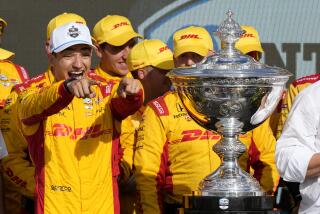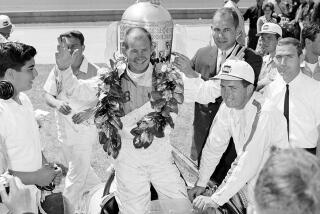A Game Is Business at 200 M.P.H.
- Share via
INDIANAPOLIS — Pay too much for that bucket of bolts they call a car, did you? Car payments, repair shop costs getting to you? Feel you’re dipping into the income too much to keep the family sedan running?
How would you feel about $20 million a year? How would you like to pay your chauffeur $3 million a year? What if you felt you needed two of them?
What if the chassis alone cost you $400,000? And that’s without the engine? The engines are so expensive you have to lease them. And you need 20 or so. And you keep a full-time set of mechanics to make sure they can keep up with traffic.
Then, what if the car you got can’t back up? Has no radio, heater, air-conditioning, stereo. No power steering. Heck, it doesn’t even have lights. No trunk. No room for passengers. What it is, really, is a lemon.
You wouldn’t be surprised to know it crashes a lot. To tell you the truth, it doesn’t even have a 500-mile warranty. It’s no cinch to go 500 miles. And, if it doesn’t, you eat it. No insurance. And don’t call the Auto Club if it breaks down.
You wouldn’t be surprised, either, to know that if you own such a car--or cars--you need a movie star for a partner.
How about Paul Newman? It’s either him or some Rockefeller.
Carl Haas could tell you all about it. Carl, you’d have to say, is a professional car owner. Which is to say, he has owned more cars that break down before 200 miles than a guy who trades in at a used-car lot called Honest John’s.
When you run an operation such as Carl Haas’, you need a lot more partners than one film actor. You need corporate America in the picture. Running a race car is about like running the Queen Elizabeth II. You go to Texaco, Kmart, Havoline, Gillette. You go to the deepest pockets you can find.
It’s quite a sales pitch. “How would you like to go partners in a near-new, one-owner vehicle, not under factory warranty, gets about 1.9 to 2 miles per gallon in highway driving, hard on tires, runs only on exotic fuel, positively needs maintenance by six to eight trained mechanics or it won’t run. No backup lights--in fact, no lights at all--stalls out under 100 m.p.h., turns left only. If it turns right, close your eyes and try to curl up in a ball. And pray.”
Owning a race car or race cars used to be sort of a hobby or avocation--like owning a string of polo ponies. It was for people who owned banks or railroads or otherwise had money to, so to say, burn.
For Carl Haas, it has always been a business. “I treated it as just another industry,” he says. “It had other than an emotional interest for me.”
A driver himself in the Sports Car Club of America, he gravitated away from the family business (leather goods) and immersed himself in racing machines, which he has made into an international conglomerate.
He campaigned in the various minor leagues of the sport, such as the Can-Am series, where he proved to be a super-organizer and routinely fielded superbly set-up machines that won races and annual titles. The international champion, Jacky Ickx, was one of his drivers.
It was only after he hooked up briefly with the Can-Am and former Indy driver, Masten Gregory, that he became he became interested in the 500.
He found a kindred spirit in the Academy Award actor, Paul Newman. Haas had an intriguing proposal for him. “Paul,” he purred, “why don’t we pool our efforts and get an Indy car team?”
Newman, who admits he was tired of being a dilettante owner--”I was taking a beating financially,” he told a Chicago writer--was cautiously interested. “Who will we get to drive for us?” he wanted to know. “How about Mario Andretti?” Haas proposed.
Haas signed Andretti: “Mario’s interest was in a team that could win. He didn’t want other drivers on the team. He wanted full concentration on him.”
The first year of the Newman-Haas collaboration, driver Andretti crashed into a spinning car (Johnnie Parsons’) on Lap 80 and fell out of the Indy 500.
In 1985, he was able to avoid a crash by adroit steermanship in the famous 360-degree Danny Sullivan spin, but Andretti lost the most ground in the subsequent yellow light and lost the race by 3/100ths of a mile an hour.
In 1987, Mario won the pole and was turning the race into a cakewalk when his engine conked out on Lap 180. He had led the race for (count ‘em) 170 laps. “It was the most devastating, heartbreaking, devastating race of my career,” Haas says. “We were leading the race by two laps and coasting all day.”
Adds Haas: “We haven’t had the best of luck at Indy.” Unfortunately, luck is no lady at Indy.
Haas wanted to spread his investment. He had enough equipment to supply two chauffeurs. Aware that Mario Andretti, like any good Italian tenor, preferred to solo, Haas didn’t propose just any partner. He picked a promising young driver who looked to him like the nearest thing to a Mario Andretti he could find. Mario was more than agreeable. The new driver was his oldest son, Michael.
The public perception of race drivers is that, like golfers, they play for the prize money. Not so. Haas notes they are high-salaried employees: “They’re athletes like Michael Jordan and you have to pay them like Michael Jordan.”
With a front line of Andretti and Andretti, the Newman-Haas team makes the playoffs at Indy every year.
Michael fell three seconds short of Victory Lane last year and was leading the race after 450 miles before Rick Mears slipped past him and won, despite leading only 30 laps total.
The first two rows of the race this year are full of Andrettis, as usual. Papa Mario is anchoring the front row, No. 1 son is anchoring the second row (another son, Jeff, starts in the seventh row).
Michael won the Indy car series last year with a record eight victories. “He hasn’t even fully peaked yet,” Haas says. “I think he’s the best Indy driver out there today.”
The game is different today, Haas contends. “Indy races used to be made up of wealthy owners who would get in it for four years or so, then leave. Now, you have to get sponsorship. You have to persuade them of the benefits.
“You have to show them the returns they get which are, in order: 1) publicity; 2) corporate entertainment, and 3) advertising. You convince them of that to spread (underwrite) your expense.”
I’ll drink to that. I wonder if I can get Havoline to split my Cadillac lease with me? I’ll let them paint a can on the front door. Maybe I’ll get an Andretti to drive it.






